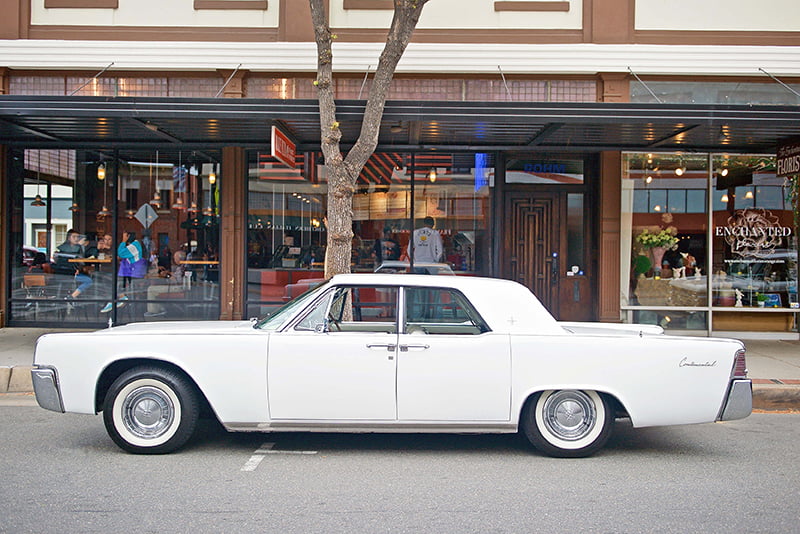Originally used on horse-drawn carriages, how on earth did suicide doors become a one time staple on many automobiles – and why did they slowly disappear?
Suicide doors is the term we use for doors hinged at the rear, that open outwards in the opposite direction compared to other conventional doors. Today, they can be found in a small collection of modern vehicles such as the Mazda RX and the Opel Meriva. Arguably, the most recognisable usage of suicide doors can be found in the entire line up of Rolls-Royce.
Even today, many automobile manufacturers shy away from using the term ‘suicide doors’. Rolls-Royce and Lincoln use coach doors, Opel refers to them as flex doors, and Mazda got even more creative and used freestyle doors. However, the inclusion of suicide doors is more prevalent in concept cars as opposed to road legal vehicles for good reason – after all, the name for these doors speaks volumes in itself.
The Origins Of Suicide Doors In Automobiles
The use of suicide doors can be traced all the way back to the first half of the twentieth century, when horse drawn carriages were much more common. Designers would source inspiration from architecture, which in this era included the French style double doors used in the abodes of the upper class. As the carriage designers wanted the fruits of their labour to ideally be seen as a symbol of status, it was inevitable that they attempted to replicate these visual luxuries.
After the introduction of the internal combustion engine, cars in the early twentieth century were referred to as ‘horseless carriages’. Their bodies are similarly shaped to a horse carriage, with the primary point of difference being that they were powered by the Internal Combustion Engine instead of being drawn by an actual horse.
As they were still incredibly expensive to purchase and operate, the same French door design – or the first suicide doors – still carried over to cars built in this era as a means to acknowledge the owner’s wealth. They also gave carriages, coaches and early cars an elegant look while serving at least some function, as they were easier to enter in and exit from, especially for higher-class women who wore long dresses and gowns attending a special event.
However, as time went by, cars began to get bigger, and in turn, faster – making the inclusion of suicide doors notably more dangerous than more traditional automotive doors. In theory, the forward motion of a car could cause the door to fly open, exposing the unlucky passenger to potentially being pulled out of the car or the door itself being ripped from its hinges. With the first generation of suicide doors coming of age in the 1930’s and popularised by the ‘gangsters’ of the time, there were no seatbelts at the time to hold any passengers safely in the backseat in the event of an accident.
On top of this, should someone accidentally open the door whilst in transit, instead of working to keep the door shut, the road wind serves as an accelerator in potentially flinging the door open. Despite manufacturers shunning the term and it’s associated bad press, ‘suicide doors’ nevertheless became the name used to describe vehicles that used this form of rear hinge configuration.
Despite the above, suicide doors have a few advantages compared to conventional doors. Rear-hinged doors allow easier access entering and exiting the car, allowing the passenger to enter by just turning to sit and to exit by stepping forward and out. Suicide doors also allow chauffeurs easier access to the rear door, which is of course not as uncommon as you might think if you’re the proud owner of one of the Rolls-Royce that feature these inclusions.
In recent years, rear-hinged rear doors that cannot be opened until the front doors are opened have started to appear on a number of vehicles, such as in extended-cab pickup trucks, the Saturn Ion Quad Coupe, the Honda Element, the Toyota FJ Cruiser, the BMW i3, and the Mazda RX-8. While the inclusion of suicide doors isn’t completely dead, it’s still considered to be a rare addition in the automotive world today.
Your Guide To Everything Classic Cars
Finding a fellow vintage auto enthusiast can feel a bit like finding a needle in a haystack, but rest assured that Classic’s Garage understands the thrill more than most. Having spent forty years collecting anything and everything from matchbox cars to hub caps, he’s successfully followed his passion to source, collect and stock beautiful and low mileage classic automobiles from around the world. With extensive experience in the automotive industry, it was only a matter of time before Wayne expanded on his love of vintage, iconic vehicles to share his knowledge and passion with the public.
Although his passion is for automobiles built before 1978, with a particular love for Buicks, Cadillacs, Lincolns, Oldsmobiles and even Fords, Wayne is just as passionate about the stories of the owners. Just like the cars, he has found that his fellow classic car enthusiasts all have wildly different attractions and logic behind their passion or hobby, and this often translates into how the car is presented. If it’s even remotely different, rare or just plain unusual, Wayne will overcome the relevant logistical and geographical challenges of bringing the cars to his showroom in Australia.
Classic’s Garage is a showroom conveniently located at Seventeen Mile Rocks, that specialises in the restoration and sales of vintage automobiles. If you’re on the hunt for Brisbane classic cars – quite simply, Wayne is your man. If you would like to arrange a viewing or inspect any other of our classic vehicles, please get in touch with us today.

